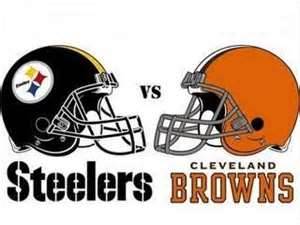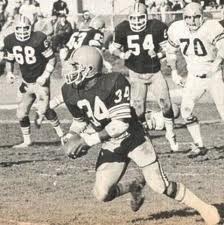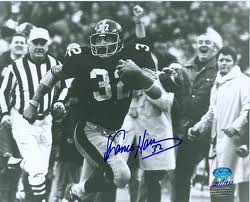
Season Series: (1-1)
The Cleveland Browns and the Pittsburgh Steelers are beginning their playoff run in the exact spot that each ended their regular season- in an entanglement with one another. Exact is a bit of a misnomer, as both teams rested starters for a great portion of the regular season finish; a game that ended as a 10-7 snorefest in favor of the Browns. Pittsburgh coach Deadfaulkner offered a confusing mix of stances toward the game. Prior to the contest, Deadfaulkner proclaimed he cared not a bit about the game; his only goal being to enter the playoffs with a healthy squad. However, down 10-0 late Deadfaulkner brought in his offensive starters, easily marching down the field in what would be Pittsburgh’s lone offensive bright spot on the day. One would think that such dominance by his one-squad would bolster his confidence heading into the playoffs, offering satisfaction that with his regular starters, the Steelers are a much more formidable team (to say the least) that would have provided the Browns with a hefty challenge. This is mentioned because that was unlike anything that transpired following the game. Instead, coach Deadfaulker was dead set upon training his thoughts on a second quarter missed field goal. Wait, didn’t the coach, prior to the game, mention that he did not care one iota if his team won or lost? Suddenly, the coach was in an uproarious frenzy over losing. That is where the regular season rivalry concluded: a game each team rendered a meaningless ‘walk though’, if you will, that culminated in a Deadfaulkner rant.
The third installment of Cleveland-Pittsburgh has the Browns traveling to Steel-town, as they did in Week 8. The playoff game should resemble Week 8 more so than Week 16, and one can strongly assume that even the hotheaded Deadfaulkner knows it. In Week 8 Pittsburgh handled the Browns 26-7, with Pittsburgh sticking mainly to a ground assault, rushing the Tecmo Legacy League’s eventual rushing champion, Franco Harris, 11 times for 123 yards. Harris also scored twice. On the other side of the ball, Cleveland, as they sometimes do, employed a two-headed QB attack, however; neither Brian Sipe, nor Dave Mays were able to offer up anything special in the game. The Browns did get a solid effort out of stud halfback Greg Pruitt, who rushed for over 100 yards on just 10 carries, but the Pittsburgh defense will tell you first hand: over half of those yards came on one rush.
On the season the Steelers were second in the league in total offensive yardage output, including finishing second in rushing. Cleveland also features a potent rushing attack behind the aforementioned Greg Pruitt, who finished the season with 1,192 yards (6th overall). As a team, Cleveland finished right behind the Steelers in terms of rushing.
Defensively, Pittsburgh ended up 8th in overall defense (in terms of yardage given up), 7th against the rush and 15th against the pass. Meanwhile the Browns concluded the regular season as the leagues 10th best defense, 17th against the rush and 13th against the pass.
It has been pointed out many times before that total yards, either offensively or defensively, often fails to prove a sound measuring stick for assessing teams. What matters most is the scoreboard. If one attempts to evaluate teams strictly from a yardage standpoint what tends to get overlooked in the statistics are meaningless yards that come after the game is out of reach, or cases where a few big plays are interspersed with a ton of ineffective plays. For the latter, an example would be a few big cheap catches scattered throughout the game, but in between mediocre to poor offensive production. It happens quite a bit, and so here we will move onto how the Steelers and Browns fared in terms of points scored and points allowed. Pittsburgh scored the 6th most points per game in the league (22.3), while surrendering the 7th least (15). Cleveland produced the 15th highest scoring team (20.3), and ranked 13th in points given up (19). In terms of points then Pittsburgh’s advantage is about a touchdown a game, while Cleveland tended to be caught up in more closely decided contests. More forcefully stated: on the season, in terms of total point differential, the Steelers outscored their opponents by 117 points while Cleveland only outscored opponents by 20 in total.
What does this all mean for the next installment of the Pittsburgh-Cleveland divisional rivalry? Pittsburgh is clearly the better overall team. This is not to simply disparage the Browns. It is merely a fact. On paper, the Steelers are a top 2 or 3 team. The same cannot be said of the Browns. However, records are not won by preseason statistical rankings. The Browns have at the helm, coach Chaos, who is currently, on the season, the top coach win percentage wise. The fact that the Browns reached a mark of (10-6) amidst a division full of stubborn foes speaks volumes. The Browns were (4-2) in the division, knocking off both the Steelers and Bengals, while sweeping Houston. Outside the division, Cleveland also managed to knock off defending Super Bowl champion Washington (a team that finished this season 11-4-1).
In order for Cleveland to win Greg Pruitt must be effective running the ball- that is where the Browns are able to do the most damage. When Pruitt becomes his unstoppable self, it importantly opens up the passing game for Sipe and Mays, two QBs finishing near the bottom of the league. The Browns need this balance to keep the Steeler defense off guard. Cleveland will have to play creatively on defense, often gambling, as well as getting lucky with picked plays, if they are to consistently stop the Steelers. Truth be told, all of Pittsburgh’s opponents have had a tough time attempting to slow down, let alone stop, the Steeler running game, so this is a lofty task for a Cleveland defense that does not feature any dominant MAN defenders. Passing wise Terry Bradshaw has been used minimally, but efficiently, throughout the season, as he has only thrown 16 TD passes (to only 4 INTs), but ended up throwing the 21st least number of attempts among the 28 regular starting QBs. In addition, Pittsburgh features two speedy and sticky-fingered wide receivers in John Stallworth and Lynn Swann. Meanwhile, the Browns have the steady Reggie Rucker at WR, but crucially lost their second WR, Paul Warfield, for the entirety of the playoffs. Cleveland is also without Cleo Miller, a hybrid running back with a valuable combination of above average HP (56) and decent speed (44). Miller often played second fiddle to the dynamic Greg Pruitt, but still gained over 500 yards rushing, despite also missing five games after injuring his ankle in Week 11. The Steelers are completely healthy on offense, but are notably without the league’s best defensive lineman, Joe Greene, who leads the league in sacks with 18. Greene also has 57 tackles, which is a ridiculous number for a defensive lineman.
In all, the Pittsburgh-Cleveland wildcard game will be a game chock full of intensity, as two divisional rivals slug it out. The game offers intrigue and excitement, as it features two of the Tecmo Legacy League’s most productive running backs, in Franco Harris and Greg Pruitt. The difference in the game may well come down to defense, and in that regard, Pittsburgh holds the trump card.




0 COMMENTS